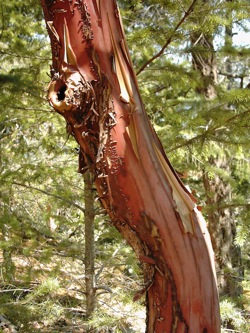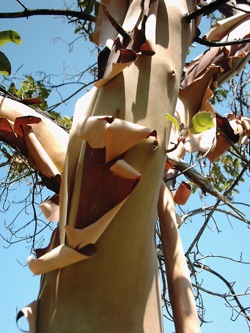The Madrone Tree
One of the World's Most Exquisite and a Favorite Tree
Magnificent, dramatic, exciting, mystical, inspiring, magical, sensual ... these are some of the words people use to describe the Madrone Tree, a favorite of the hardwood trees of the Pacific Northwest.
Few trees excite the viewer as much as these do. When visitors come from around the world and discover them in their wild habitat, the reaction is instant: they fall in love with them!
The Madrone Tree or Madrona Tree gets its name from the Spanish word madroño (which means strawberry tree...the early Spanish explorers named it after the similarities to a Mediterranean variety).
In Canada, it is known as the Arbutus Tree. The European species, while quite different, is also called a Strawberry Tree.
Why?

Because of the plentiful berries formed in the fall. While bright orange red, the Madrone tree berries are about the size of a small wild strawberry. The color stuck and Madrone or Arbutus Strawberry Tree it is.
It grows from northern California north to southern British Columbia and is found mostly there on the BC Gulf Islands, ending at the Northern Gulf Islands. Found on Cortes Island, BC, they do diminish on the north part of the island and are rare north from there as you get into a much rainier climate.
Madrone trees like sun, really like it! They will twist and turn to find it if a competing fir tree tries to outgrow it. I guess this feature of its incredible shapes is part of what makes it on the list of favorite trees!
Not only is the twisting and bending a big part of its charm, but its bark gives the tree its amazing bite!

The bark sheds in the summer revealing a silky smooth glistening pale green yellow bark underneath. As the new bark ages during the year, it turns red and then dark red.
By then it starts to peel in big shreds adding an amazing feature to the tree.
Older trees do not peel all the way down to the ground. The bark stays but has a shredded look about it often with moss growing up a bit of the tree trunk for effect!
You will also find it called Pacific Madrone or Pacific Madrona for the fact that it loves growing close to the ocean and we mean the Pacific Ocean in this case!
The Madrone tree is a Native American sacred tree. Thus the wood was never used for fire even though it burns long and hot. Sacred trees like the Arbutus tree hence make an incredible sacred pendant or sacred necklace.
No comments:
Post a Comment